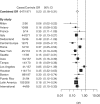Cessation of alcohol drinking, tobacco smoking and the reversal of head and neck cancer risk
- PMID: 19805488
- PMCID: PMC2817090
- DOI: 10.1093/ije/dyp291
Cessation of alcohol drinking, tobacco smoking and the reversal of head and neck cancer risk
Abstract
Background: Quitting tobacco or alcohol use has been reported to reduce the head and neck cancer risk in previous studies. However, it is unclear how many years must pass following cessation of these habits before the risk is reduced, and whether the risk ultimately declines to the level of never smokers or never drinkers.
Methods: We pooled individual-level data from case-control studies in the International Head and Neck Cancer Epidemiology Consortium. Data were available from 13 studies on drinking cessation (9167 cases and 12 593 controls), and from 17 studies on smoking cessation (12 040 cases and 16 884 controls). We estimated the effect of quitting smoking and drinking on the risk of head and neck cancer and its subsites, by calculating odds ratios (ORs) using logistic regression models.
Results: Quitting tobacco smoking for 1-4 years resulted in a head and neck cancer risk reduction [OR 0.70, confidence interval (CI) 0.61-0.81 compared with current smoking], with the risk reduction due to smoking cessation after > or =20 years (OR 0.23, CI 0.18-0.31), reaching the level of never smokers. For alcohol use, a beneficial effect on the risk of head and neck cancer was only observed after > or =20 years of quitting (OR 0.60, CI 0.40-0.89 compared with current drinking), reaching the level of never drinkers.
Conclusions: Our results support that cessation of tobacco smoking and cessation of alcohol drinking protect against the development of head and neck cancer.
Figures
References
-
- Ferlay J, Bray F, Pisani P, Parkin D. GLOBOCAN 2002: Cancer Incidence, Mortality and Prevalence Worldwide IARC CancerBase No. 5. Lyon: IARC Press; 2004.
-
- Franceschi S, Bidoli E, Herrero R, Munoz N. Comparison of cancers of the oral cavity and pharynx worldwide: etiological clues. Oral Oncol. 2000;36:106–15. - PubMed
-
- Shiboski CH, Shiboski SC, Silverman S., Jr Trends in oral cancer rates in the United States, 1973–1996. Community Dent Oral Epidemiol. 2000;28:249–56. - PubMed
-
- La Vecchia C, Lucchini F, Negri E, Levi F. Trends in oral cancer mortality in Europe. Oral Oncol. 2004;40:433–39. - PubMed
-
- Blot W, McLaughlin J, Devesa S, Fraumeni J. Cancers of the oral cavity and pharynx. In: Schoffenfeld D, Fraumeni J, editors. Cancer Epidemiology and Prevention. New York: Oxford University Press; 1996. pp. 666–80.
Publication types
MeSH terms
Grants and funding
LinkOut - more resources
Full Text Sources
Medical



